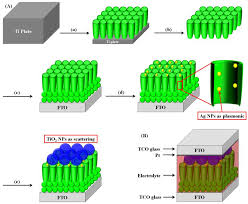
Nanostructured Solar Cells: Harnessing Nanotechnology for Clean Energy
Nanostructured solar cells are at the forefront of renewable energy technologies, offering enhanced efficiency, reduced costs, and greater flexibility compared to traditional photovoltaic systems. By leveraging nanotechnology, these solar cells aim to overcome the limitations of conventional silicon-based cells, paving the way for a more sustainable energy future.
What Are Nanostructured Solar Cells?
Nanostructured solar cells incorporate nanoscale materials and structures, such as quantum dots, nanowires, or thin films, to improve light absorption, charge transport, and overall efficiency. These cells take advantage of unique nanomaterial properties, including high surface area, tunable bandgaps, and enhanced optical characteristics.
Types of Nanostructured Solar Cells
- Quantum Dot Solar Cells (QDSCs):
- Utilize semiconductor quantum dots as light absorbers, enabling tunable bandgap properties for capturing a broader spectrum of sunlight.
- Dye-Sensitized Solar Cells (DSSCs):
- Employ dye molecules anchored on a nanostructured semiconductor to absorb light and generate electricity.
- Perovskite Solar Cells:
- Feature nanostructured perovskite materials with exceptional light-harvesting and charge transport properties.
- Thin-Film Solar Cells:
- Incorporate nanostructured thin films of materials like cadmium telluride (CdTe) or copper indium gallium selenide (CIGS) for lightweight and flexible designs.
- Nanowire Solar Cells:
- Use vertical arrays of nanowires to increase light trapping and charge collection efficiency.
Advantages of Nanostructured Solar Cells
- High Efficiency:
- Nanostructures improve light absorption and minimize energy losses, enhancing power conversion efficiency.
- Cost-Effectiveness:
- Use of less material and scalable fabrication methods reduce manufacturing costs.
- Flexibility:
- Lightweight and flexible designs allow for integration into diverse surfaces and applications, such as portable electronics and building-integrated photovoltaics.
- Enhanced Performance:
- Tunable properties of nanomaterials enable better performance in low-light and varied environmental conditions.
- Reduced Environmental Impact:
- Use of eco-friendly materials and lower energy requirements for production contribute to sustainability.
Challenges in Nanostructured Solar Cells
- Stability:
- Long-term stability under operational conditions needs improvement for commercialization.
- Scalability:
- Transitioning from laboratory-scale production to industrial-scale manufacturing remains challenging.
- Material Toxicity:
- Certain nanomaterials, such as cadmium-based compounds, pose environmental and health risks.
- Cost of Advanced Materials:
- High-purity synthesis of nanomaterials can increase production costs.
- Integration with Existing Systems:
- Adapting new technologies to existing energy infrastructure requires further innovation.
Applications of Nanostructured Solar Cells
- Building-Integrated Photovoltaics (BIPV):
- Integrated into windows, facades, and roofs for sustainable building designs.
- Portable Electronics:
- Used in lightweight and flexible solar panels for powering portable devices and wearables.
- Remote and Off-Grid Power:
- Ideal for providing electricity in remote areas and disaster relief scenarios.
- Space Exploration:
- Nanostructured solar cells’ lightweight and high-efficiency design make them suitable for powering spacecraft and satellites.
- Agricultural Applications:
- Deployed in solar-powered irrigation and greenhouses to enhance agricultural productivity.
Future Directions
- Hybrid Materials:
- Combining nanomaterials with conventional materials to improve performance and durability.
- Quantum Efficiency Optimization:
- Advancing designs to maximize quantum efficiency and energy conversion rates.
- Eco-Friendly Nanomaterials:
- Developing non-toxic and sustainable nanomaterials for safer and greener production.
- Energy Storage Integration:
- Integrating nanostructured solar cells with advanced storage systems for uninterrupted power supply.
- Artificial Intelligence (AI) in Design:
- Leveraging AI for optimizing nanostructure configurations and predicting performance under varying conditions.
Conclusion
Nanostructured solar cells are transforming the renewable energy landscape with their innovative designs and superior performance. By addressing current challenges and scaling up production, these advanced photovoltaics hold the potential to make clean energy more accessible and efficient. As research progresses, nanostructured solar cells will play a crucial role in driving the global transition to sustainable energy solutions.
